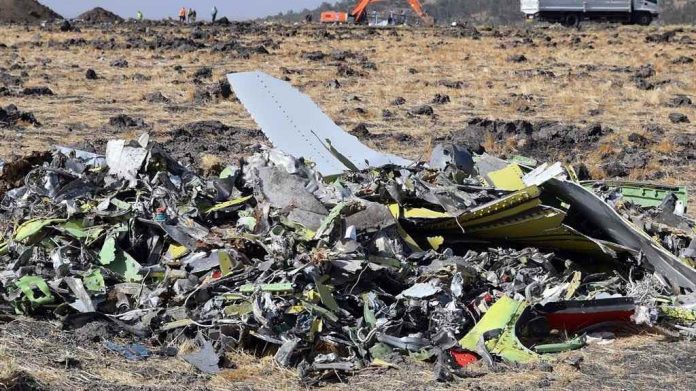Ethiopian investigators have found that the pilots of the Boeing 737 Max that crashed killing all 157 people on board last month were not to blame and called on the US manufacturer to carry out a full investigation into the anti-stall system thought to be at fault for the accident.
The preliminary findings of the investigation into the crash of Ethiopian Airlines flight 302 released on Thursday said the pilots had correctly followed emergency procedures, heaping further pressure on Boeing to fix a flawed software system implicated in a previous deadly crash in Indonesia.
In an unprecedented move, regulators around the world grounded the 737 Max worldwide in the wake of the Ethiopian accident. The tragedy followed the crash in October of a Lion Air 737 Max flight in Indonesia, in which the anti-stall system — known as the Manoeuvring Characteristics Augmentation System (MCAS) — appears to have contributed to bringing the plane down.
Dagmawit Moges, Ethiopian minister of transport, called on Boeing to carry out a full review of the anti-stall system before the 737 Max is allowed to return to service.
Coming within five months of each other, the two crashes have badly shaken public confidence in the latest version of the 737, Boeing’s best-selling plane and a workhorse of the world aviation industry. It has also raised serious concerns about Boeing and the procedures used by the US Federal Aviation Administration (FAA) to certify aircraft as safe to fly.
In a video message published on Thursday, Boeing’s chief executive Dennis Muilenburg said that most air accidents are caused by “a chain of events”. He said: “This again is the case here, and we know we can break one of those chain links in these two accidents. As pilots have told us, erroneous activation of the MCAS function can add to what is already a high workload environment,” he said.
“It’s our responsibility to eliminate this risk. We own it and we know how to do it.”
Boeing said that it had a software fix for the problem and new training materials were under development “to ensure unintended MCAS activation will not occur again”.
The Ethiopian report said that the aircraft’s nose was forced down four times by the automated system. The crew repeatedly tried to use the procedure set out by Boeing to overcome such a situation but they were unsuccessful because the manual wheel meant to bring the nose back up was “not working”, according to the report.
The report captures how little time the pilots had to regain control of the aircraft during the six minutes it was in the air, as they battled to override the anti-stall system, which was pushing the aircraft into a dive.
Ms Dagmawit said the crew of the Ethiopian Airlines flight, flying from Addis Ababa to Nairobi in Kenya on March 10, “performed all the procedures repeatedly provided by the manufacturer but were not able to control the aircraft”.
The FAA, which is working with Ethiopia on the crash investigation, said: “As we learn more about the accident and findings become available, we will take appropriate action.”
MCAS is an automated stall prevention system that if triggered can, under certain circumstances, force down the nose of the aircraft even if pilots are flying it manually. This can push the jet into a steep dive, making it impossible to control. MCAS receives information from sensors on the angle of the aircraft’s nose in relation to the airstream and is unique to the Max.
Earlier versions of the 737 have different stall-protection systems that do not automatically drive down the nose.
“Since repetitive, uncommanded aircraft nose-down actions were noticed in this preliminary investigation, it is recommended the aircraft flight control system shall be reviewed by the manufacturer,” Ms Dagmawit said.
Amdiye Ayalew, head of the Ethiopian investigation, said that it was still too early to say whether there was a “structural design problem” with Boeing’s aircraft. However, he also said that, from data collected, there was no evidence that any foreign object had damaged the plane and caused the crash.
Boeing said it was reviewing the report. In line with international rules on air accidents, the preliminary report did not attribute blame. A final report is not due for many months.
Aviation consultant John Strickland, of JLS Consulting, said there was not “complete clarity” when Boeing’s Max aircraft could fly again.
Ethiopian Airlines said the preliminary report “clearly showed” that the pilots had followed the emergency procedures recommended by Boeing and approved by the FAA.








